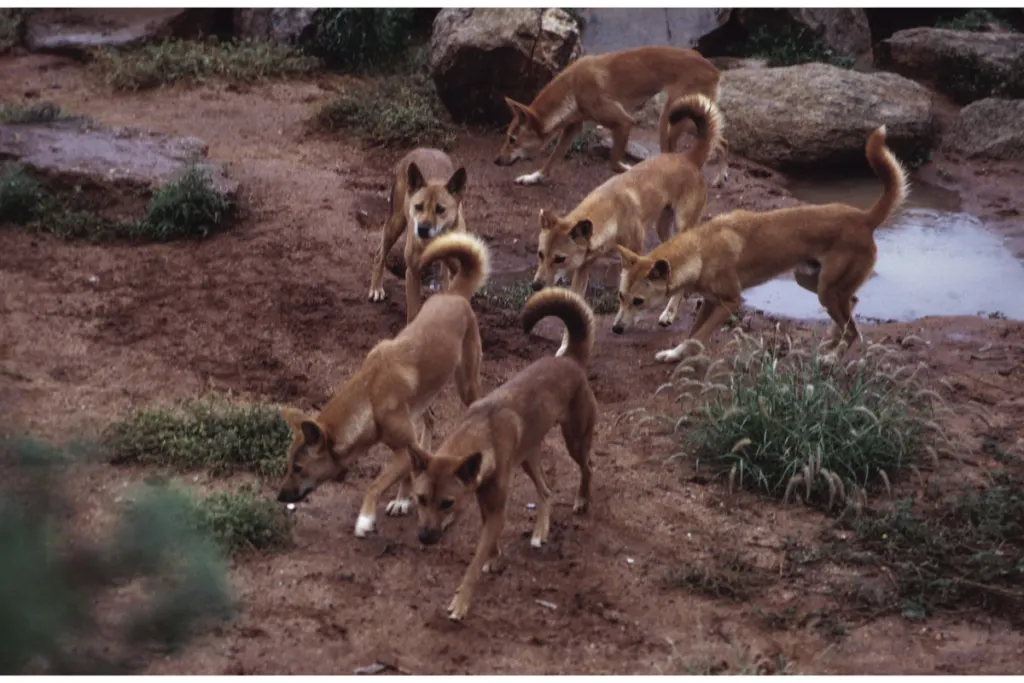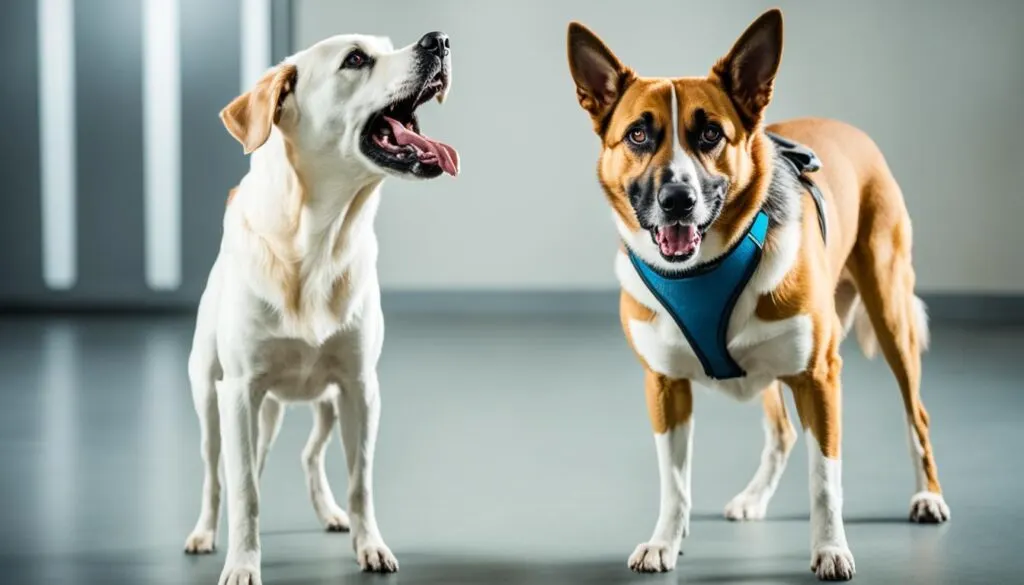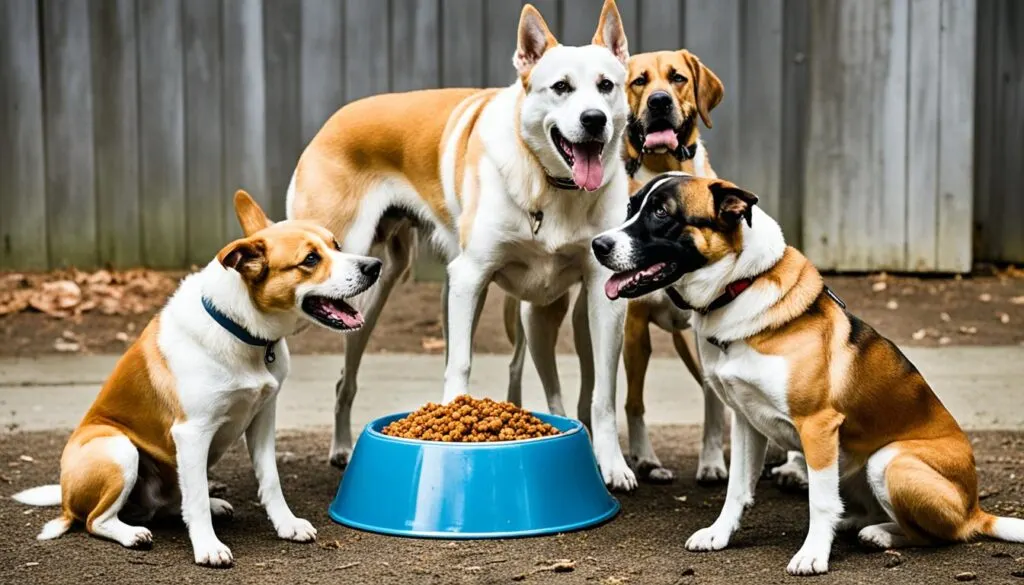Canine behavior can be both fascinating and puzzling at times.
There are many questions that arise when it comes to understanding how dogs interact with each other and the world around them.
One common question that dog owners often wonder about is, “Will a dog eat another dog?”
To shed some light on this intriguing topic, let’s dive into the world of dog behavior and explore the factors that contribute to canine aggression and predatory instincts.
By understanding the natural instincts and behaviors that drive dogs, we can gain valuable insights into their interactions with other dogs and ultimately answer the question at hand.
So, let us embark on this journey of exploration as we delve into the complexities of canine behavior and separate the facts from the fiction surrounding dogs eating other dogs.

Click Here to Jump to a Section
Key Takeaways:
- Understanding canine aggression requires an exploration of natural predatory instincts.
- The question of whether a dog will eat another dog entails separating myth from reality.
- Common causes of dog aggression can be addressed through effective interventions and training.
- Insights into the hierarchy within dog packs can shed light on dominance and submission in feeding behavior.
- Preventing behavioral issues related to dog eating behavior requires proactive strategies and redirecting unwanted behaviors.
Exploring the Roots of Canine Aggression and Predatory Instincts
Dogs possess innate predatory instincts that can significantly impact their behavior.
Understanding these instincts is crucial when examining canine aggression.
This section aims to shed light on the natural prey drive of dogs and how it influences their actions.
Additionally, it clarifies misconceptions surrounding interspecies aggression in dogs.
Understanding Canine Predatory Instincts
Canine predatory instincts have deep evolutionary roots.
Dogs are descendants of wolves, who were highly skilled predators.
These instincts have been passed down through generations, manifesting in dogs’ innate drive to chase and capture prey.
The prey drive, also known as predatory drive, is a natural instinct that varies in strength among individual dogs.
It is influenced by factors such as breed characteristics and training experiences. Dogs with a strong prey drive may exhibit intense focus, high energy, and a natural inclination to chase and capture moving objects.
This instinctual behavior is often observed during play, where dogs engage in activities such as chasing toys, running after balls, or engaging in simulated hunting games.
It is essential for dog owners to understand and manage this instinct to prevent it from escalating and causing harm or aggressive behavior towards other animals or even humans.
Interspecies Aggression in Dogs: Myth vs. Reality
Interspecies aggression refers to aggressive behavior displayed by dogs towards animals of different species, such as cats, birds, or smaller pets.
However, it is crucial to separate myth from reality when it comes to this topic.
Contrary to popular belief, not all dogs are inherently aggressive towards other species.
While some dogs may display aggressive behavior towards certain animals, others can coexist peacefully.
Factors such as socialization, training, and individual temperament play significant roles in determining a dog’s behavior towards other species.
It is essential for dog owners to expose their pets to various species and provide proper socialization from a young age.
This can help dogs develop appropriate behaviors and minimize the risk of aggression towards other animals.
It is worth noting that while predatory instincts and interspecies aggression can be related, they are not synonymous.
Dogs with a strong prey drive may exhibit chasing behavior towards smaller animals, but it does not necessarily imply aggression towards them.
To gain more insight into the complex relationship between predatory instincts, canine aggression, and interspecies interactions, it is crucial to examine individual cases, consider factors such as breed tendencies, and work closely with experienced trainers or animal behaviorists.
Will a Dog Eat Another Dog? Separating Facts from Fiction
There is a common misconception surrounding the question of whether dogs will eat other dogs.
In this section, we aim to provide accurate information and dispel any misconceptions about dog eating behavior.
Dog eating behavior is influenced by various factors, including instinct, environment, and individual temperament.
While it is true that dogs are descendants of wolves and possess predatory instincts, it is important to separate fact from fiction when it comes to cannibalistic behavior.
While there have been rare cases of dogs exhibiting cannibalistic behavior, these instances are the exception rather than the norm.
Dogs are not natural cannibals, and the vast majority of them do not have the inclination to eat other dogs.
It is important to remember that dogs are social animals with intricate social structures.
Aggression between dogs can occur, but it is usually related to establishing dominance, protecting resources, or defending themselves.
Cannibalism, on the other hand, is a highly abnormal behavior that typically occurs in extreme cases of starvation, neglect, or severe psychological distress.
To illustrate the rarity of dogs eating other dogs, we can look at the millions of households worldwide that have multiple dogs living together peacefully.
These dogs coexist, play, and share resources without any inclination to harm or consume each other.
Ultimately, it is crucial to separate fact from fiction when discussing dog eating behavior.
While it is important to remain vigilant and address any aggression or behavioral issues in dogs, it is not accurate to believe that a dog will routinely eat another dog.

Common Causes of Dog Aggression and Interventions
Dog aggression can stem from various factors.
Understanding these common causes is essential in effectively managing and modifying aggressive behavior in canines.
Additionally, implementing proper training techniques can help prevent dog-on-dog aggression.
One prevalent cause of aggression in dogs is resource guarding.
Resource Guarding: A Normal Yet Manageable Behavior
Resource guarding refers to a dog’s instinct to protect valuable resources, such as food, toys, or territory.
While this behavior is normal, it can escalate into aggression if not properly addressed.
Recognizing the signs of resource guarding, such as growling, snapping, or stiff body language, is crucial. Interventions for managing resource guarding include:
- Gradually desensitizing the dog to the presence of people or other animals near valuable resources
- Using positive reinforcement techniques to teach the dog to willingly share or release the guarded resource
- Implementing a consistent feeding and management routine to prevent situations that trigger resource guarding
Managing and Modifying Aggressive Behavior in Canines
Dealing with aggressive behavior in dogs requires proper management and modification techniques. Some strategies to consider include:
- Identifying potential triggers and avoiding or minimizing exposure to them
- Seeking professional guidance from a qualified dog behaviorist or trainer
- Implementing positive reinforcement training methods to redirect aggressive behavior towards more desirable actions
- Providing a safe and structured environment to reduce stress and anxiety
The Role of Training in Preventing Dog-on-Dog Aggression
Training plays a vital role in preventing dog-on-dog aggression.
By providing dogs with proper socialization and obedience training, they can learn appropriate behaviors and responses towards other dogs.
Key training techniques include:
- Gradually introducing dogs to new experiences and environments
- Teaching dogs basic commands, such as “sit,” “stay,” and “leave it”
- Using positive reinforcement to reward desirable behavior
- Regularly engaging in controlled and supervised interactions with other dogs
The Hierarchy Within the Dog Pack: Dominance and Submission in Feeding
Dogs have a hierarchical social structure within their packs, with one or multiple leaders and followers.
Understanding dog pack dynamics is crucial for comprehending their behavior, especially when it comes to feeding.
Dominance and submission play significant roles in determining which dogs get access to food and when.
Dog Pack Dynamics: Leaders and Followers
In a dog pack, there are typically one or more leaders who establish and maintain their position through dominant behavior.
These leaders are often the first to approach and consume food, asserting their authority over the rest of the pack.
The followers, on the other hand, exhibit submissive behavior and wait for the leaders to finish before accessing their share of the meal.
Dominance and submission in feeding are part of the natural hierarchy within a dog pack.
It is essential to recognize that dominance does not equate to aggression or cruelty.
It is a natural behavior that helps maintain order and structure within the pack.
Providing Balanced Nutrition Among Pack Members
When it comes to feeding a dog pack, it is crucial to ensure that all members receive balanced and appropriate nutrition.
Just like humans, dogs have individual dietary needs and requirements.
Providing the necessary nutrients for optimal health and well-being is vital for every dog within the pack.
Feeding a balanced diet helps maintain the physical and mental health of each dog and contributes to harmony within the pack.
It minimizes the risk of competition and resource guarding, reducing the likelihood of aggression during feeding time.

Strategies for ensuring fair and healthy feeding practices in a dog pack include:
- Feeding dogs separately, if necessary, to prevent food-related conflicts.
- Using multiple feeding stations to allow each dog to eat in a calm and controlled environment.
- Supervising feeding sessions to monitor behavior and intervene if necessary.
- Consulting with a veterinarian or animal behaviorist to develop a feeding plan that meets the nutritional needs of all pack members.
By understanding the hierarchy within a dog pack and providing balanced nutrition to all members, it is possible to promote peaceful feeding and reduce the risk of dominance-related conflicts.
Preventing Behavioral Issues Related to Dog Eating Behavior
When it comes to dog eating behavior, it’s important to take proactive steps to prevent any potential behavioral issues.
By understanding the root causes of unwanted behaviors and implementing effective strategies, you can ensure a safe and healthy environment for your canine companion.
Redirecting Unwanted Behavior: Techniques and Strategies
One of the key aspects of preventing behavioral issues is redirecting unwanted behavior in dogs.
If your dog shows signs of resource guarding or exhibits a tendency to eat inappropriate items, it’s crucial to intervene before the behavior escalates.
Positive reinforcement techniques can be highly effective in redirecting your dog’s attention and encouraging more desirable behaviors.
For example, offering a high-value treat or engaging your dog in interactive play can help shift their focus away from food or forbidden items.
Consistency and patience are key in this process, as it takes time and repetition for behavior patterns to change.
Maintaining Health and Hygiene After Ingestion of Inappropriate Items
Ingestion of inappropriate items can pose health risks to dogs, making it essential to prioritize their well-being.
If your dog consumes something they shouldn’t, it’s vital to monitor their behavior closely and be aware of any signs of distress or discomfort.
Contacting your veterinarian for guidance is advisable, as they can provide specific instructions based on the situation.
In some cases, inducing vomiting may be necessary, while in others, supportive care or medical intervention may be required.
It’s important to remember that prevention is the best approach, so ensuring a safe environment and eliminating access to dangerous objects is crucial.
Additionally, maintaining good hygiene is essential after ingestion of inappropriate items.
Paying attention to your dog’s stool and observing any changes in their digestive system can help detect and address potential issues early on.
Regular veterinary check-ups, proper nutrition, and providing chew toys or appropriate alternatives can aid in preventing such incidents from occurring in the first place.
